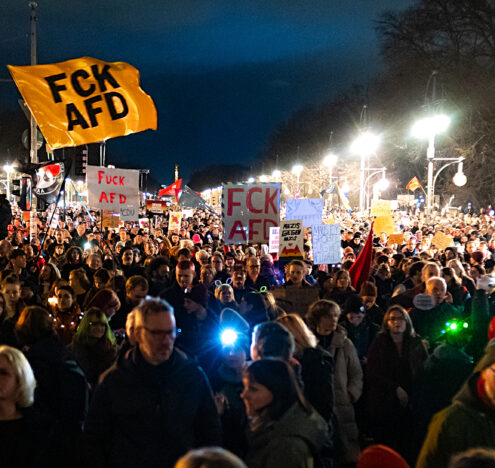“Adults in a Room” is a series in collaboration with The Stimson Center’s Reimagining US Grand Strategy program. The series stems from the group’s monthly networking events that call on analysts to gather virtually and hash out a salient topic. It aims to give you a peek into their Zoom room and a deep understanding of the issue at hand in less than the time it takes to sip your morning coffee without the jargon, acronyms, and stuffiness that often come with expertise.
President Donald Trump has radically reoriented US policy toward the war in Ukraine, launching direct talks with Russia, publicly feuding with Ukraine’s president, and temporarily pausing US support to Ukraine to push it into negotiations. While Ukraine recently endorsed a 30-day ceasefire, Russia believes the battlefield momentum is on its side, and it will be no easy task to reach a lasting peace.
February’s Reimagining US Grand Strategy roundtable brought members of the foreign policy community together to discuss the outlook for diplomacy to end the Russia-Ukraine war. The conversation began with remarks from two guest speakers, who provided an overview of the current state of negotiations, the likely contours of a settlement, and the leading challenges to reaching a deal. The group discussed and debated the prospects for a negotiated settlement and the question of security guarantees for Ukraine.
Emma Ashford, Senior Fellow, Reimagining US Grand Strategy Program, Stimson Center
The Trump administration has initiated a stunning about-turn in US policy toward Ukraine since entering office in January. The new administration has pivoted from the Biden administration’s “nothing about Ukraine without Ukraine” approach toward what appears to be a dual-pronged pressure approach — pushing both Ukraine and Russia towards the negotiating table.
Though the process has been characterized by Trump’s normal bombastic approach — blow-ups with Zelensky in the Oval Office, shut-offs of aid, high-powered summits in Saudi Arabia — there does appear to be substance beneath the reality TV show. The administration is advocating an initial short ceasefire, followed by further talks. And though it remains unclear whether Russia would agree to a ceasefire while it has the upper hand on the ground, the fact is that both parties do have some interest in coming to the table at this point in the war.
For Ukraine, the situation is worse. Ukrainian troops continue to lose ground, including most recently, the land they had occupied near Kursk in Russia. The country faces manpower and logistical issues. Russia is far better placed in terms of raw numbers and ability to supply its military machine. But the Russian economy is suffering under sanctions, and Trump’s apparent goodwill toward Moscow offers a window to extricate themselves from Ukraine that may not reoccur.
If negotiations do kick off in earnest, conversation will have to focus on resolving four key sets of concerns. First is the question of territory. This is perhaps ironically the easiest to resolve and is likely to fall near the de facto lines of territorial control today. Second, and much harder, are issues of sovereignty and alignment. Though often framed around the question of whether Ukraine will be admitted to NATO, this is actually a broader set of questions about the extent to which Ukraine will be able to achieve its stated goal of integrating with the West — economically, militarily, or otherwise. This set of issues will also include concerns about arms and armament: to what extent will Ukraine or Russia be limited in the arms that they can keep near frontlines or the foreign troops they can host on their own soil?
A third set of concerns are the practical nuts and bolts of peace. A demilitarized zone will need to be created, with some form of monitoring or peacekeeping, and all the nitty-gritty details of a ceasefire will need to be hashed out. Finally, there are financial issues. For Russia, the biggest incentive to negotiate now is the prospect of sanctions relief, but whether the United States or European countries are willing to offer this — or to release impounded Russian reserves — remains an open question.
Will Walldorf, Professor in the Department of Politics and International Affairs, Wake Forest University
When (and if) US relations with Ukraine get back on track, the initial step to cooperation will likely be signing the minerals deal that was shelved after the recent blowup at the White House. The deal has been widely reported, but not given much critical attention given the dominant focus of public debates about negotiating an end to the Russia-Ukraine War. That’s not a good thing.
The allure of accessing rare earth minerals has been a dangerous strategic trap for great powers, including the United States in recent decades. Minerals were one reason US troops kept fighting in Afghanistan after doing so no longer made strategic sense. Though the ISIS Caliphate is gone, US troops are still in Syria today to control its oil fields (a decision Trump made in 2019). Finally, in Africa, today, Russia faces the dangers of overstretch as it tries to protect access to African minerals — nearly 100 Russian soldiers have died in Mali while trying to protect mines since last summer.
Helping Ukraine use its natural resources to rebuild is a good idea. Still, if Trump’s not careful, his obsession with Ukrainian minerals could lead to outcomes at odds with US national interests.
Two things compound this danger. First, Trump officials see the presence of US miners and engineers in Ukraine as a form of deterrence against Russian aggression, and thus protection for Ukraine. The danger? Deterrence doesn’t really work this way, especially when an aggressor (like Russia) cares little about collateral damage. After Oct. 7, 2023, Hamas tried to use civilians to deter Israeli bombing. We all know how that turned out. In short, rather than deterrents against aggression, chances are high US mining personnel in Ukraine will be targets for attacks, especially by Russian proxies.
Second, the location of Ukrainian strategic minerals makes attacks on US personnel more, not less, likely. Forty percent or more of the mineral deposits are in eastern Ukraine, where most fighting with Russia has occurred since 2014 and Russian nationals comprise the majority of the population. That’s an especially dangerous place for US miners and engineers to be. If they face a surprise proxy attack, Trump may feel inclined to protect them. That could easily lead to a US military presence or security guarantees for Ukraine. Trump doesn’t want that. Neither do the US citizens. The United States has bigger strategic fish to fry elsewhere, notably in Asia to manage a rising China.
Washington has plenty of stable allies with expansive supplies of strategic minerals. So, it’s best to not get too obsessed with Ukraine’s strategic minerals. Let’s hope the Trump administration can keep that in view as it works to bring the Ukraine war to an end.
Dani Nedal, Assistant Professor in the Department of Political Science and Munk School of Global Affairs & Public Policy, University of Toronto
Ukraine and its European partners should not waste any more time, energy, or political capital on getting a security guarantee from the United States as a condition for a ceasefire agreement or other political settlement to the Russo-Ukrainian war. Not only is such a guarantee not forthcoming, but it would be virtually meaningless if offered. In the best of times, even formal alliance treaties have their reliability routinely questioned and require substantial investment of financial and political resources to render credible. We are decidedly not living in the best of times.
The Trump administration has demonstrated profound disdain for international agreements and norms, including the most foundational principles of international law. The president has a penchant for discarding or disrespecting multilateral and bilateral treaties with America’s closest, oldest, and most steadfast allies and partners. He has threatened to use economic coercion or military force to acquire territory from Panama, Gaza, Denmark/Greenland, and Canada, and has shown more interest in sharing in the spoils of Russian conquest than in defending European countries against it.
Ukraine and its European partners should not waste any more time, energy, or political capital on getting a security guarantee from the United States.
Accordingly, most of America’s erstwhile allies are now scrambling to adjust to the realization that not only can they not rely on the US for protection, but they might in fact need protection from the US. What value could there be in any kind of assurance or guarantee coming from such a source?
In this new environment, Ukraine would be best served by security guarantees from European sources. France, the United Kingdom, Germany, and Poland should be ready to provide such a guarantee even if they are, understandably, unsure of whether they could militarily oppose Russia without US backing and whether such a guarantee would be enough to dissuade Putin from reneging on yet another agreement.
When negotiating an end to war, assurances from third parties are generally less about deterring future conflict than they are about offering partners with the political cover needed to accept less-than-ideal terms and escape hurting stalemates or, worse, prevent a decisive military defeat. Europeans will struggle — and likely fail — to promptly and fully replace American material and intelligence support for Ukrainian troops. Political support in the form of an explicit security guarantee is one thing that Zelensky and Ukraine need right now that Europe can deliver, and at relatively little cost.
Marcus Stanley, Director of Studies, Quincy Institute for Responsible Statecraft
Developments around the Ukraine conflict have been moving at a dizzying pace — fast enough to embarrass anyone who tries to write about them in advance. Indeed, the day after the Stimson Center brought together experts for the discussion leading to these essays, we saw the unprecedented public conflict between President Trump and Zelensky in the Oval Office. That certainly wasn’t something any of us expected.
But beneath the sometimes surprising twists and turns of public actions by the US, Europe, and Ukraine, the core drivers of the conflict have remained steady. It’s these underlying factors which will have to be addressed to bring a cease fire and eventually a lasting peace. Put simply, for decades, Russian leaders have seen a militarily powerful and Western-aligned Ukraine on its border as a direct threat to its national security. In turn, the Ukrainian leadership sees Russia as an implacable aggressor that can only be deterred by a militarily powerful Ukraine (or, what amounts to the same thing, by a firm guarantee of direct Western military support for Ukraine).
It’s difficult to settle two such seemingly irreconcilable interests within the framework of a peace treaty rather than a decisive victory by one side over the other. During the hour-long Oval Office meeting between Trump and Zelensky, it was this core conflict, not simple rudeness or temperament, that drove their eventual blow-up. From the beginning of the meeting, Trump was optimistic about rapid progress toward a ceasefire. But Zelensky repeatedly contested whether a ceasefire was possible without American security guarantees of direct military engagement in the conflict should the ceasefire collapse. From the moment Trump tried to pull Ukraine toward negotiations, they insisted on the centrality of their need for military forces strong enough to defeat Russia on the battlefield.
For its part, Russia has so far indicated no willingness to back off from its initial peace offer made in the 2022 Istanbul negotiations, which called for a neutral and demilitarized Ukraine, and has in addition made clear that NATO or US military forces on the Russian border to keep the peace would be a non-starter. In the recent Putin-Trump phone call, Russia underlined that Ukrainian rearmament and continued US military aid were barriers to a ceasefire.
For a lasting peace to be created this fundamental conflict must be bridged in negotiations. Even reaching a ceasefire may require beginning to address them. Doing so will require reconsideration of the oversimplified claims that many have made since 2022, such as insisting that Russian security interests in a neutral Ukraine had nothing to do with the origins of the war.
Yet there are reasons for optimism. In its 2022 Istanbul offer, Russia had already indicated that it would accept Ukrainian membership in the EU and backed away from its initial effort to conquer and occupy most or all of Ukraine. Indeed, three years of war have clearly demonstrated that such an occupation would be militarily impossible. Thus, Russia has signaled its potential willingness to accept a sovereign and Western-aligned Ukraine across most of its territory — a historic step for independent Ukraine. Negotiators must now craft a way for the two countries to coexist on some other basis than the expectation of future war.
Michael Desch, Director of the Notre Dame International Security Center and Packey J. Dee Professor of Political Science, University of Notre Dame
While we are by no means close to a ceasefire and eventual peace agreement in Ukraine, it has become widely recognized that there is no other way to end the war with Russia. The high hopes during the heady days of 2022 for a Ukrainian victory, including liberation of Russian-occupied territories, have been dashed by grinding but inexorable Russian advances on the ground over the past year. Not surprisingly, debate is shifting toward what to do to bolster Ukrainian security once the shooting stops.
Discussion ranges from integrating what remains of independent Ukraine into NATO to deploying European peacekeepers to maintaining a large, Western-armed Ukrainian military. Of course, such ambitious plans are financially and demographically infeasible for Ukraine and its European supporters, unacceptable to Russia, and not even necessary.
Indeed, analysts of the restraint perspective have long been thinking about less provocative and more cost and manpower effective ways to bolster Ukrainian deterrence that ought to be part of this discussion moving forward. As a result of MIT’s Barry Posen’s 1994 study, and continuing with recent work by the Stimson Center’s Emma Ashford and Jennifer Kavanagh of Defense Priorities, much of the initial spadework is already done.
Still, there remains space for further conceptual analysis of how new developments in weapons technology (especially first-person video drones) can further augment what Clausewitz identified long ago as the defenders’ advantage on the battlefield. Old military technologies such as fortifications, which Russian forces used with great effect to stymie the 2023 Ukrainian offensives, might also be turned to Kyiv’s advantage. Finally, there was some really innovative European defense analysis near the end of the Cold War on strategies of “defensive-defense” that, combined with early Ukrainian success with man-portable anti-tank weapons, could provide another arm in a potent Ukrainian conventional deterrence posture.
Ukraine and the West squandered opportunities early in the war to end it before the human and territorial costs became intolerable; they should not lose the opportunity now to think outside the box in an effort to bolster Ukraine’s peacetime security.
Andrew Latham, Professor of International Relations, Macalester College
The unipolar moment is over, and no amount of wishful thinking will restore it. The world has entered a fully multipolar era, where no single power can impose its will unchecked. Instead of clinging to a crumbling “rules-based international order” that never truly constrained great powers, the United States should take the lead in forging a new equilibrium — one that acknowledges multipolarity not as a crisis, but as a condition to be managed. The model? A modern Concert of Powers, loosely inspired by the 19th-century Concert of Europe, but recalibrated for today’s geopolitical realities.
The original Concert of Europe was neither utopian nor idealistic. It was a cold-blooded mechanism for maintaining stability among competing powers, recognizing that peace depended not on shared values but on carefully managed balances of interest. It worked — not perfectly, but well enough — for nearly a century. The same logic can apply today.
A modern Concert of Powers would bring together the world’s key players — America, China, Russia, India, and the European Union — accepting that competition is inevitable but confrontation is not. It would rest on two pillars: balance and restraint. Each major power would recognize the fundamental interests of the others, and while tensions would persist, the goal would be to contain conflict, not eliminate it. This does not mean capitulation to autocrats, but it does mean abandoning the illusion that liberal democracy will govern the international system. It won’t. The system will be governed, as it always has been, by power, interests, and prudence.
Critics will say this is dangerous, that it risks legitimizing authoritarian regimes. But the alternative is worse: an ideological crusade to uphold an already crumbling order, pushing the world closer to great-power war.
The war in Ukraine is a case in point. The failure to secure a negotiated settlement — despite the grinding costs on all sides — illustrates the perils of an uncompromising, ideological approach to diplomacy. A modern Concert of Powers could provide a structured framework for such negotiations, recognizing that any lasting peace will require a balance of interests, not just military outcomes or moral grandstanding. If the West truly seeks stability in Ukraine and beyond, it must engage in pragmatic diplomacy, not maximalist demands.
The United States must resist the temptation to frame every geopolitical struggle as a battle between good and evil. It should instead use its still-formidable power to shape a stable balance — one that accepts diversity in political systems while maintaining a firm deterrent against revisionist aggression.
This will require hard choices. It means acknowledging spheres of influence, setting clear red lines, and, most controversially, recognizing that absolute US primacy is no longer sustainable. But the reward is a world where power is managed, not unleashed. The alternative is chaos.
The question is not whether a Concert of Powers is desirable. The question is whether we have the strategic imagination to make it work.




















